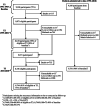Developing a gender measure and examining its association with cardiovascular diseases incidence: a 28-year prospective cohort study
- PMID: 39468490
- PMCID: PMC11520886
- DOI: 10.1186/s12916-024-03706-3
Developing a gender measure and examining its association with cardiovascular diseases incidence: a 28-year prospective cohort study
Abstract
Background: Cardiovascular diseases (CVD) are the leading cause of morbidity and mortality worldwide. Examining gender (socio-cultural) in addition to sex (biological) is required to untangle socio-cultural characteristics contributing to inequities within or between sexes. This study aimed to develop a gender measure including four gender dimensions and examine the association between this gender measure and CVD incidence, across sexes.
Methods: A cohort of 9188 white-collar workers (49.9% females) in the Quebec region was recruited in 1991-1993 and follow-up was carried out 28 years later for CVD incidence. Data collection involved a self-administered questionnaire and extraction of medical-administrative CVD incident cases. Cox proportional models allowed calculations of hazard ratios (HR) and 95% confidence intervals (CI), stratified by sex.
Results: Sex and gender were partly independent, as discordances were observed in the distribution of the gender score across sexes. Among males, being in the third tertile of the gender score (indicating a higher level of characteristics traditionally ascribed to women) was associated with a 50% CVD risk increase compared to those in the first tertile (HR = 1.50; 95% CI: 1.24 to 1.82). This association persisted after adjustment for several CVD risk factors (HR = 1.42; 95% CI: 1.16 to 1.73). Conversely, no statistically significant association between the third tertile of the gender score and CVD incidence was observed in females (HR = 0.79, 95% CI: 0.60-1.05).
Conclusions: The findings suggested that males within the third tertile of the gender score were more likely to develop CVD, while females with those characteristics did not exhibit an increased risk. These findings underline the necessity for clinical and population health research to integrate both sex and gender measures, to further evaluate disparities in cardiovascular health and enhance the inclusivity of prevention strategies.
Keywords: Cardiovascular diseases incidence; Characteristics related to gender; Epidemiology; Gender measure; Occupational health; Sex.
© 2024. The Author(s).
Conflict of interest statement
The authors declare that they have no competing interests.
Figures


References
-
- O’Reilly D, Rosato M. Worked to death? A census-based longitudinal study of the relationship between the numbers of hours spent working and mortality risk. Int J Epidemiol. 2013;42(6):1820–30. - PubMed
-
- (Dis)connected: how unseen links are putting us at risk — 2019 report on heart, stroke and vascular cognitive impairment. [www.heartandstroke.ca/-/media/pdf-files/canada/2019-report/heartandstrok... (accessed 2019 May 17).]
-
- Tsao CW, Aday AW, Almarzooq ZI, Anderson CAM, Arora P, Avery CL, Baker-Smith CM, Beaton AZ, Boehme AK, Buxton AE, et al. Heart Disease and Stroke Statistics—2023 Update: A Report From the American Heart Association. Circulation. 2023;147(8):e93–621. - PubMed
-
- Benjamin EJ, Muntner P, Alonso A, Bittencourt MS, Callaway CW, Carson AP, Chamberlain AM, Chang AR, Cheng S, Das SR, et al. Heart Disease and Stroke Statistics-2019 Update: A Report From the American Heart Association. Circulation. 2019;139(10):e56–528. - PubMed
Publication types
MeSH terms
LinkOut - more resources
Full Text Sources

